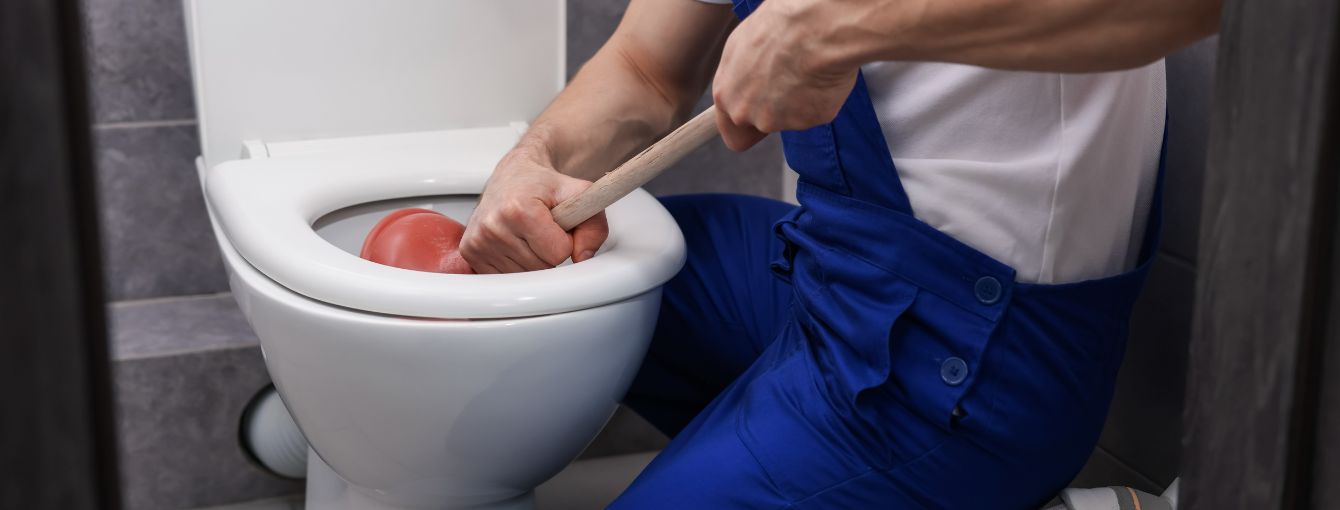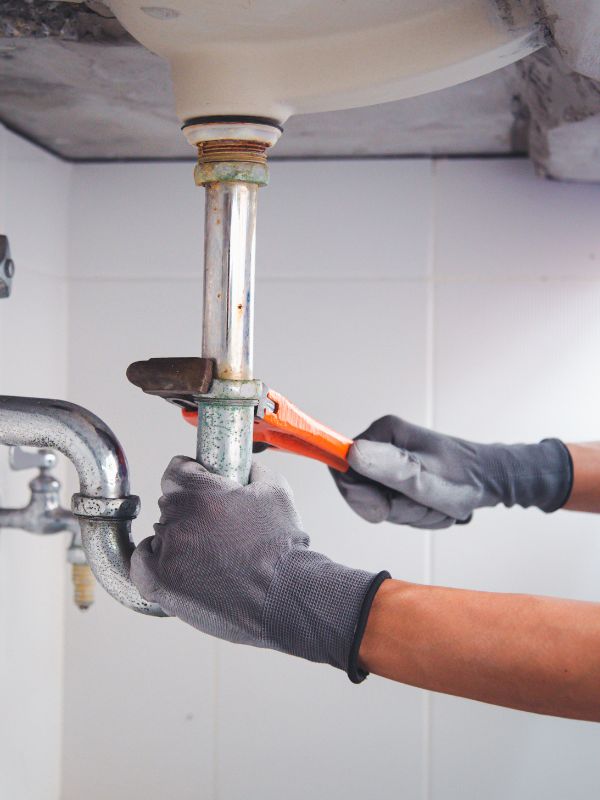Clogged drains and toilets are a common and frustrating problem for many in McKinney, Texas. While it may be tempting to use a chemical drain cleaner, these products can damage pipes.
The following are methods for unclogging drains and toilets. If these techniques don’t work, you may need to contact the trusted plumbing professionals at Bewley Plumbing.
Unclogging Toilets

There are several ways to try to unclog a toilet, including:
Using a Plunger
When using a plunger to unclog a toilet, be sure to use a flange plunger, which is identifiable by its extra rubber lip. Be sure to wear gloves when using this method.
- Step 1. Determine the Toilet’s Water Level: Before trying the plunger, check the water level in the toilet. Make sure the toilet’s water level is high enough to completely cover the rubber piece of the plunger, but not to the point that the water will overflow.
- Step 2. Get the Plunger in Place: Cover the drain’s opening with the plunger to form a seal. Be sure to press the plunger gently at first so any trapped air is pushed out. This helps prevent water from splashing out of the bowl.
- Step 3. Use a Strong and Steady Motion on the Plunger: Use a strong, but steady motion on the plunger without going too fast or too slow.
- Step 4. Repeat if Needed: If using the plunger doesn’t work the first time, it’s a good idea to try a few more times. Certain clogs may take several attempts with a plunger to clear. If the plunger doesn’t work, you have several other DIY methods at your disposal.
Using Hot Water and Soap
If the plunger isn’t working on your toilet clog, you can try using soap and hot water. This technique is excellent for clogs caused by excessive organic material or toilet paper, as it helps to loosen debris and doesn’t damage pipes.
- Step 1. Remove Excess Water from the Toilet if Needed: When a toilet clogs, it may be close to overflowing. As this process involves adding water, you may need to remove some water from the toilet if it is too high. Take a disposable container and take enough water out so you’ll have room to add a gallon or so more water.
- Step 2. Use Dish Soap: Squirt a ½ cup of liquid dish soap into the toilet. The soap helps lubricate the clog so it can slide down the drain. Liquid hand soap or shampoo can be substituted for dish soap if necessary.
- Step 3. Use Hot (But NOT Boiling) Water: Take a bucket and fill it with roughly a gallon of hot (NOT boiling) water. If poured directly into a cold porcelain toilet, boiling water could crack the porcelain. The temperature of the water should be comparable to a hot cup of tea.
- Step 4. Carefully and Slowly Pour the Hot Water: With the container at roughly waist height, carefully pour the hot water into the toilet. Take care not to accidentally burn yourself in the process. Pouring the water from higher up adds pressure that helps dislodge the clog. Once the water has been poured, allow the soap and water mixture to sit for 10 to 15 minutes to allow the blockage to break up.
- Step 5. Flush the Toilet and Repeat the Process if Needed: When you’ve finished waiting for the mixture to sit, flush the toilet. If the water drains as it should, the clog has been resolved. If it doesn’t, try the hot water and soap method one more time.
Using Vinegar and Baking Soda
The combination of vinegar and baking soda creates a fizzing solution that can help unclog drains.
- Step 1. Make Sure the Toilet Bowl has the Right Amount of Water: Before putting anything into the toilet, ensure the toilet’s water is at the correct level. The ideal water height for this is roughly half-full. Having the toilet water halfway full enables the vinegar and baking soda to mix and react properly, but it isn’t high enough that the water will overflow. If the water is too high, you’ll need to remove some. If the water is too low, carefully pour hot, but not boiling water into the bowl until the water is at the halfway point.
- Step 2. First, Slowly Pour in the Baking Soda: Slowly pour a cup of baking soda into the toilet. Adding baking soda first allows for even distribution and won’t cause an immediate reaction when coming into contact with the vinegar before it can get to the clog.
- Step 3. Slowly Pour in the Vinegar: After adding the baking soda, carefully pour two cups of distilled vinegar into the toilet. Take care to pour the vinegar gradually to prevent excessive fizzing that could result in the toilet overflowing. The bubbling reaction of vinegar and baking soda helps unclog the drain.
- Step 4. Wait for 30 Minutes: Once you’ve added the vinegar, allow the mixture to sit for at least 30 minutes. In those 30 minutes, the baking soda’s fizzing and the vinegar’s acidity help to break down materials that may be behind the clog.
- Step 5. Look for Signs that the Vinegar and Baking Soda are Working, and Flush the Toilet: Once you’ve waited 30 minutes, look for the following signs that indicate the clog is loosening:
- Bubbles rise from the bottom of the toilet bowl.
- The water level is lower.
If you see these signs in your toilet bowl, flush it. If the water drains smoothly, the clog is cleared. If you still have a problem, try this method one more time.
Unclogging Drains
As with toilets, there are several ways to unclog drains. The following are a few examples.
Using a Plunger to Unclog Tub, Sink, or Shower Drains
A standard bell-shaped plunger can clear tub, sink, and shower drains.
- Step 1. Get a Washcloth Wet If Not Working on a Shower Drain: If you aren’t working on a shower drain, get a washcloth thoroughly wet and set it somewhere for future use.
- Step 2. Take Out the Drain Cover or Stopper: Take out the pop-up drain stopper from the drain on the sink or bathtub. If you’re working on a shower, you’ll need to remove the drain grate.
- Step 3. If Necessary, Add Water: Use a cup or bucket to pour enough water to cover the cup of a plunger.
- Step 4. Cover the Overflow Hole, if Needed: Take the wet washcloth and fold it in the shape of a square. Use the washcloth to cover the tub or sink’s overflow hole (showers do not typically have these). Ideally, you’ll want a helper to hold the washcloth in position so you can work the plunger with both hands.
- Step 5. Get the Plunger into Position: Put the cup of the plunger in the water at an angle, so that it can fill with water.
- Step 6. Work the Plunger: Firmly push the plunger up and down. Do this several times.
- Step 7. Allow Hot Water to Run: Once the drain has been cleared, allow hot water to run for a few minutes.


Using Vinegar and Baking Soda to Unclog a Drain
Instead of harmful drain cleaners, you can use vinegar and baking soda in an attempt to unclog your drain.
What You’ll Need:
Materials:
- Distilled white vinegar
- Grease-fighting dish soap
- Boiling water
- Baking soda
Equipment:
- Funnel
- Tea kettle, or a pourable measuring cup that can handle boiling water
- Step 1: Boil Water: Begin by boiling water in a tea kettle placed on a stove top or a pourable measuring cup in the microwave.
- Step 2. Squirt Dish Soap and Pour Boiling Water into the Drain: Take a little grease-fighting dish soap and squirt it into the drain. Then, carefully pour the water you boiled into the drain. Take care to ensure you aren’t burned if any water splashes back.
- Step 3. Pour 1 Cup of Baking Soda Down the Drain: Pour a cup of baking soda down the drain. You can do this by using a measuring cup, or if your drain is smaller and it is hard to pour straight into the opening, you can use a funnel instead.
- Step 4. Pour a Cup of Distilled White Vinegar Down the Drain: Pour a cup of distilled white vinegar down the drain. You’ll hear a noise that signifies a reaction.
- Step 5. Use More Hot Water to Flush the Mixture: Wait for five minutes after the fizzling noise has stopped. While you are waiting, boil two cups of water. When the five minutes have passed, flush the drain with the two cups of boiling water.
If your drain has begun flowing, turn on the hot water tap to flush the debris down the drain. If the drain hasn’t begun to flow, try repeating the previous steps. If your drains haven’t been cleaned in a while, you may need to repeat the process at least twice.
When to Contact a Plumbing Professional
If you encounter frequent drain clogging and these home remedies aren’t solving the issue, you’ll want to contact a professional plumber. If a clog is bad enough, it can potentially cause a pipe to leak or burst, so you’ll want to take action quickly.
Contact Bewley Plumbing today for more information on our drain and sewer services or to schedule an appointment.
Additional Resources:
- 6 Signs It’s Time to Replace Your Water Heater in McKinney, TX
- Exploring the Hazards of Hidden Plumbing Leaks
- Winter Plumbing Tips for McKinney and Collin County Homes
- Exploring Electronic Leak Detection Technology for Plumbing – A Guide by Bewley Plumbing
- Troubleshooting Why Your Water Heater Is Running Out of Hot Water
- How to Troubleshoot Leaking Faucets and Fixtures in McKinney



